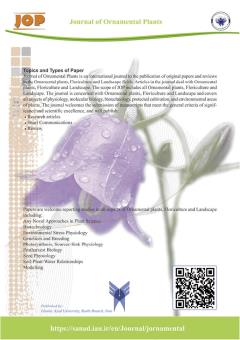تأثیر گونههای گیاهی زینتی در کاهش آلودگی و تصفیه هوای اماکن ورزشی
الموضوعات : مجله گیاهان زینتی
جلیل پورزرنگار
1
![]() ,
فیروزه پورزرنگار
2
,
فیروزه پورزرنگار
2
1 - دکتری تخصصی مدیریت ورزشی، دانشگاه تهران، ایران
2 - گروه علوم باغبانی، واحد رشت، دانشگاه آزاد اسلامی، رشت، ایران
الکلمات المفتاحية: گیاهان زینتی, ورزش, مجموعه ورزشی, آب و هوا.,
ملخص المقالة :
گیاهان زینتی یکی از ارزانترین و طبیعیترین عناصر برای تصفیه هوا و کاهش آلودگی هستند. توانایی این نوع از گونههای گیاهی در جذب آلایندهها و تصفیه هوا غیرقابل انکار است. امروزه بهدلیل صنعتیشدن و پیشرفت فنآوری، آلودگی هوا و محیطزیست به یک دغدغه مهم در کشورهای درحال توسعه تبدیل شده است. هدف از این تحقیق تأثیر گونههای گیاهی زینتی در کاهش آلودگی و تصفیه هوای اماکن ورزشی میباشد. آلایندههایی که پاکیزگی هوای اماکن ورزشی را تحت تأثیر قرار میدهند، شامل: بنزن، فرمالدئید، منوکسیدکربن، تریکلرو اتیلن، آمونیاک، دود و زایلن میباشند. هشت گونه گیاهی شامل: پاپیتال، آلوئهورا، پوتوس، نخل خرما، گیاه عنکبوتی، سانسوریا، سرخس بوستون و نخل خیزران برای تصفیه هوا و کاهش آلودگی آلایندهها مورد بررسی قرار گرفتند. با توجه به نتایج تحقیق(P < 0/05) ، اطلاعات لازم برای پیشبینی همبستگی تصفیه هوا با گونههای مختلف گیاهی از نظر آماری نشان داد که براساس مدل، هشت گونه گیاهی موردمطالعه با تصفیه هوا و کاهش آلودگی فضاهای ورزشی همبستگی طبیعی دارند و سانسوریا بیشترین تأثیر را در کاهش آلودگی و تصفیه هوای اماکن ورزشی دارد (بتا = 348/0، مقدار ارزش = 966/0). نتایج نشان داد که در هر نقطه از جهان، گونههای گیاهی موردمطالعه از مؤثرترین گونهها در تصفیه هوا هستند، بنابراین برای خیابانها، پارکها و مکانهای ورزشی مناسب هستند. پیشنهاد میگردد که با استفاده از نتایج این تحقیق، مسئولان و دست اندرکاران مربوطه، توجه و بهرهگیری بیشتری را در استفاده از گیاهان مذکور برای بهبود کیفیت هوای شهر و اماکن ورزشی داشته باشند.
Akhavan Markazi, V., Naderi, R., Danaei, E., Kalatejari, S. and Nematolahi, F. 2021. Comparison of plant remediation power of two ornamental plants Pothos and Snake plant when faced with indoor air pollution. Jornamental Plants, 12(3): 235-245.
Amirimehr, M. 2020. How to maintain and grow all kinds of houseplants, Afarineshe Mehr Publications.
Annals Statistics. 2017. View, Landscape, and Beautification Organization. Guilan Province, Rasht City, Iran.
Barona, C.O. 2015. Adopting public values and climate change adaptation strategies in urban forest management: A review and analysis of the relevant literature. Journal of Environmental Management, 164: 215- 221.
Cai, K. and Li, C. 2019. Street dust heavy metal pollution source apportionment and sustainable management in a typical City-Shijiazhuang, China. International Journal of Environmental Research and Public Health, 16: 1-15.
Dabiri, M. and Bashiribod, S. 2014. Environmental pollution: air-water-soil-sound, Tehran: Publishing Ettehad.
Eslamian, S., Abedi, J. and Goohari, A. 2009. Investigating the use of bamboo straw nanoparticles in improving the engineering properties of water structures, The third national conference on the experiences of constructing irrigation and drainage networks.
Fatehifar, E., Arejani, M. and Kahfrooshan, E. 2012. Air pollution in closed environments and ways to reduce it, National conference on air flow and pollution.
Hakimzadeh Ardekani, M.A., Kousari, M.R. and Esfandiari, M. 2014. Assessment and mapping of desertification sensitivity in central part of Iran. International Journal of Advanced Biological and Biomedical Research, 2(5): 1504-1512.
Hakimzadeh, M.A. 2014. Assessment of desertification risk in agricultural land in south of Iran. International Journal of Advanced Biological and Biomedical Research, 2 (3): 669-681.
Hamedani, M. 2022. Investigation of the plant Hedera helix and its medicinal properties. The 5th National Conference on the Development of Science and New Technologies in Medicinal Plants, Chemistry and Biology of Iran, Tehran.
Immig, J. and Rish, S. 1997. Indoor air quality guidelines for Sydney Olympic facilities. Bondi Jungtion, Sydney, Australia: Green Games Watch 2000.
Kuhns, M. and Rupp, L. 2000. Selecting and planting landscape trees. Utah State University Extension, Logan, Utah. 2th Edition: 48.
Lohe, R.N., Tyagi, B., Singh, V., Tyagi, P., Khanna, D.R. and Bhutiani, R. 2015. A comparative study for air pollution tolerance index of some terrestrial plant species. Global Journal of Environmental Science and Management, 1: 315–324.
Mahmoosisafa, J., Nasrolahnejad, S. and Mostafavi, F. 2016. Detection and identification of tomato ring spot virus in ornamental plants in North Khorasan province. Journal of Ornamental Plans, 6(3): 141-150.
Mohammad Khabbaz, M. 2014. The role of plants in reducing air pollution. Journal of livestock and culture: 169.
Najafi, M., Raeisi, M., Tokhmkar, S. and Moradi, B. 2016. A review of Aloe Vera medicinal plant. The first national conference of aromatic and spicy medicinal plants. GonbadKavoos University.
Osku, M., Khandan Mirkohi, A. and Naderi, R. 2022. Influence of different nitrate levels of nutrient solution on morphological and physiological characteristics of spider plant (Chlorophytum comosum). Journal of Horticultural Plants Nutrition, 5(1): 125-137.
Petrova, S.T. 2011. Biomonitoring study of air pollution with Betula pendula Roth., from Plovdiv, Bulgaria. Ecologia Balkanica, 3(1):1-10.
Pluschke, P. 2012. Indoor air pollution. Translators: Jonidi Jafari, A. and Moazen, B. Tehran: Publishing Hadian.
Sajjadi, S.N. 2017. Design and maintenance management of sports facilities and equipment, Publishing Avaye Zohor.
Salimi, L. and Sahraei, J. 2016. Investigating indoor air quality in dusty conditions in Kermanshah city, National conference to fight against fine dust and air pollution.
Tajik, J., Mohammad Jalali, A. and Dehghanipour, M. 2022. Production and cultivation of ornamental plants. Department of Agriculture and Food, 5th edition.
Wolverton, B., Johnson, A. and Bounds, K. 1995. Interior Landscape Plants for Indoor Air Pollution Abatement. NASA Stennis Space Center; Stennis, Space Center, MS, United States.


